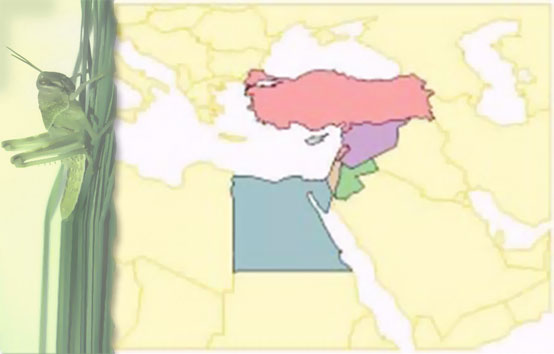Tribolium confusum Jacquelin du Val
Taxonomic position: Insecta, Holometabola, Coleoptera, Tenebrionidae.
Common name: Confused flour beetle.
Geographic distribution: Worldwide, especially in cooler regions.
Morphology: Body of adults flat, reddish-brown, about 4 mm long, thorax slightly darker then the elytra, densely punctated. Elytra with punctate, parallel-sided striations. Last four antennal segments larger, almost square. Larvae initially whitish, later becoming brown, length up to 5 mm. Last segment with two dark, pointed and sclerotized projections.
A molecular method for detecting T. confusum has been developed and may serve as a supplemental means for the quantitative assessment of infestations.
Host plants: Dried foods, including grain products and fruits, chocolate, pet foods and dried flowers.
Life history: The adults are long-lived, sometimes for more than 3 years. Females may lay 300-600 eggs which are covered with a sticky material to which flour particles adhere. The hatched larvae feed on any available food for about 3-4 weeks and pupate. A life cycle requires 7 to 12 Weeks, dependent on the prevailing temperatures. They do not fly.
Economic importance: This beetle is a major pest of stored products. It infests mostly seeds, kernels and other products that had already been damaged by other pests, or wounded during harvest and storage, usually not undamaged seeds. Economic losses consists of reduced weight and quality, difficulties in baking, reduced marketability of infested products and an accompanying unpleasant smell. In addition, T. confusum is an allergen that may cause allergies in bakers.
Management
Physical control: Sanitation, removal and destruction of potential sources of infestations, including all grain products, pet foods, nuts, spices and other dried foods. Cleaning any small bits of grain that have fallen from leaking packages. If infestations are found, the store or shelves should be vacuumed and the area around the infestation thoroughly cleaned. Suspected grain products may be stored in containers with tight fitting lids, or in a freezer for 4-5 days, or, if possible, at temperatures of 50°C. Modified atmospheres, reducing the O2 levels and increasing those of CO2, or vacuuming, are applicable in closed spaces or those that can be sealed by plastic sheets. The application of diatomaceous earth (DE) to adult T. confusum that infest wheat resulted in 100% mortality, only in 60-80% in maize. Pest populations originating from different European regions differed in their in their susceptibility to DE.
Chemical control: Direct applications of a pyrethrin aerosol on the beetle resulted in almost 90% mortality, but less when applied onto infested flour. Treating pest larvae with insect growth regulators (IGRs) resulted in malformed beetles or in much reduced adult emergence. Control was also achieved with a pyrethroid alone or when combined with an IGR, and with spinetoram. Essential oils extracted from Eucalyptus saligna Sm. and from Cupressus sempervirens L., and impregnated on filter paper discs, or coated onto maize grains, caused much pest mortality. They also curtailed progeny production, reduced grain weight loss and had a strong repellent activity against the beetle.
Biological control: The application of 20,000 juvenile entomopathogenic nematodes to wheat infested by T. confusum resulted in about 56% pest mortality.
References
Arthur, F.H. 2015 Residual efficacy of pyrethrin + methoprene for control of Tribolium castaneum and Tribolium confusum in a commercial flour mill. Journal of Stored Products Research 64: 42-44.
Athanassiou, C.G., Kavallieratos, N.G., Menti, H. and Karanastasi, E. 2010. Mortality of four stored product pests in stored wheat when exposed to doses of three entomopathogenic nematodes. Journal of Economic Entomology 103: 977-984.
Finkelman, S., Donahaye, E., Dias, R., Rindner, M. and Azrieli, A. 2002. Integrated storage pest control methods using vacuum or CO2 in transportable systems. In: Adler, C., Navarro, S., Scholler, M. and Stengard-Hansen, L. (Editors) Proceedings of the International Organization for Biological Control and Integrated Control of Noxious Animals and Plants, Vol. 3, University of Gent, Belgium. pp. 207-214.
Kharel, K., Arthur, F.H., Zhu, K.Y., Campbell, J.F. and Subramanyam, B. 2014. Evaluation of synergized pyrethrin aerosol for control of Tribolium castaneum and Tribolium confusum (Coleoptera: Tenebrionidae). Journal of Economic Entomology 107: 462-468.
Navarro, S., 2006. Modified atmospheres for the control of stored-product insects and mites. In: Heaps J.W., (Editor). Insect Management for Food Storage and Processing (2nd edition), St. Paul: AACC Int., pp. 105-146.
Nowaczyk, K., Obrepalska-Steplowska, A., Gawlak, M., Throne, J.E., Olejarski, P. and Nawrot, J. 2009. Molecular techniques for detection of Tribolium confusum infestations in stored products. Journal of Economic Entomology 102:1691-1695.
Schultze-Werninghaus, G. (and 7 co-authors) 1991. Tribolium confusum (confused flour beetle, rice flour beetle) – an occupational allergen in bakers: demonstration of IgE antibodies. International Archives of Allergy and Immunology 94: 371–372.
Tapondjou, A.L., Adler, C., Fontem, D.A., Bouda, H. and Reichmuth, C. 2005. Bioactivities of cymol and essential oils of Cupressus sempervirens and Eucalyptus saligna against Sitophilus zeamais Motschulsky and Tribolium confusum du Val. Journal of Stored Products Research 41: 91–102.
Vassilakos, T.N. and Athanassiou, C.G. 2012. Effect of short exposures to spinetoram against three stored-product beetle species. Journal of Economic Entomology 105: 1088-1094.
Vayias, B.J., Athanassiou, C.G., Kavallieratos, N.G. and Buchelos, C.T. 2006. Susceptibility of different European populations of Tribolium confusum (Coleoptera: Tenebrionidae) to five diatomaceous earth formulations. Journal of Economic Entomology 99:1899-1904.
